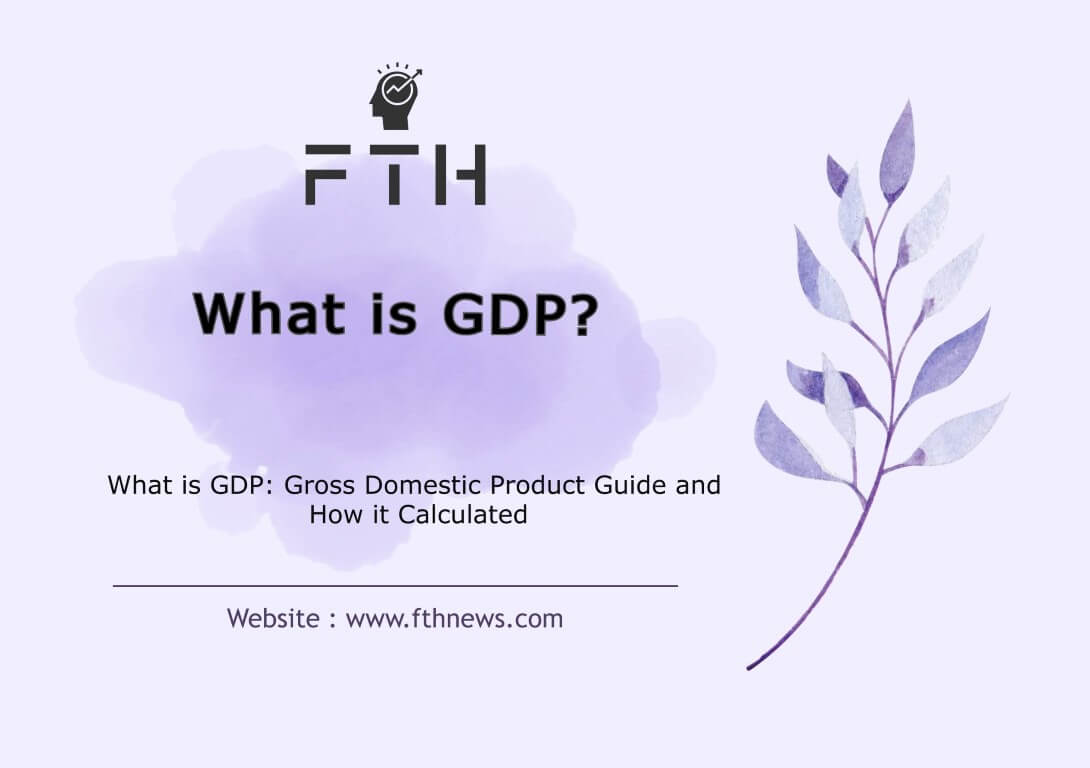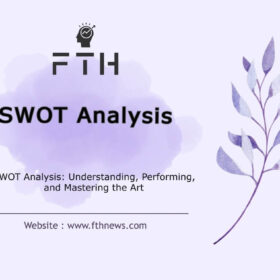
What is GDP: Gross Domestic Product Guide to How it Calculated
What is GDP ? In strategic decision-making processes, policymakers, businesses, and investors often analyze macroeconomic factors to gauge the current situation and guide their actions. One crucial macroeconomic factor is Gross Domestic Product (GDP), considered a vital measure of national success and economic growth.
Understanding Gross Domestic Product (GDP):
Gross Domestic Product (GDP) stands as a pivotal macroeconomic indicator designed to gauge the economic well-being of a country. It serves as a comprehensive measure, encapsulating the total market value of all goods and services produced within the confines of a nation’s borders over a specified time frame. In this comprehensive guide, we navigate through the historical evolution of Gross Domestic Product, delve into its fundamental features, explore the diverse methods employed for its calculation, and elucidate the distinctions between its nominal and real forms.
At its core, Gross Domestic Product encompasses a myriad of economic activities, capturing the total market value of goods and services produced within a country during a specified period. Our exploration extends beyond the surface, dissecting the main features that make GDP a vital yardstick for assessing economic health. From its inclusivity of all economic endeavors to its measurement based on specific time intervals, this section illuminates the defining characteristics of Gross Domestic Product.
Our article delves into the history of GDP, its main features, how it is calculated using different methods, and the types of GDP – nominal and real.
The Historical Evolution of GDP
The inception of Gross Domestic Product can be traced back to the turbulent times of 1937, a response to the economic upheaval of the Great Depression. Born out of necessity, the concept aimed to provide a comprehensive measure of a nation’s economic activity, transcending traditional metrics. However, its emergence was not without skepticism and criticism.
An Idea Forged in Crisis: GDP’s Genesis During the Great Depression
The proposal of Gross Domestic Product in 1937 reflected a visionary response to the unprecedented challenges posed by the Great Depression. As nations grappled with economic turmoil, economists sought a more encompassing measure that could capture the intricacies of economic performance beyond traditional indicators.
Resilience in the Face of Doubt: Widespread Adoption Post-Bretton Woods
Despite initial criticism, the concept of GDP demonstrated remarkable resilience. It was the Bretton Woods conference in 1944 that marked a turning point, propelling Gross Domestic Product into widespread usage. The conference, designed to rebuild the global economic framework after World War II, acknowledged GDP as a crucial tool for assessing and comparing the economic well-being of nations.
USA’s Embrace: Official Adoption in 1991
The United States, a key player in the global economic landscape, took a significant step in recognizing GDP as the official measure of economic well-being. In 1991, the USA officially adoptedGross Domestic Product, solidifying its status as the primary yardstick for evaluating economic performance. This move underscored the recognition of GDP’s versatility and its ability to provide a nuanced understanding of a nation’s economic health.
Emphasizing Significance: GDP as a Pillar of Economic Assessment
The adoption of GDP as the official measure in 1991 highlighted its significance in guiding economic policy and decision-making. Over time, GDP has evolved into more than just a metric; it has become a pillar of economic assessment, providing a comprehensive and standardized approach to measuring the well-being of nations.
In the subsequent sections of our exploration, we delve into the main features of Gross Domestic Product, the intricacies of its calculation methods, and the types of Gross Domestic Product that shape our understanding of economic dynamics. Join us as we unravel the layers of Gross Domestic Product, from its historical roots to its contemporary role in shaping our economic narratives.
Main Features that Define GDP
Gross Domestic Product , as a comprehensive economic metric, is characterized by distinctive features that make it a fundamental yardstick for assessing a nation’s economic well-being. In this segment, we dissect the main features that define GDP, offering a nuanced understanding of its scope and significance.
Encompassing All Economic Activities
At its essence, GDP goes beyond mere sectors or industries; it is an encompassing measure that considers all economic activities within the borders of a country. Whether in the realms of manufacturing, services, or agriculture, Gross Domestic Product casts a wide net, ensuring a holistic representation of a nation’s economic landscape.
Final Goods and Services in Focus
GDP zeroes in on the culmination of economic processes, considering only final goods and services. By excluding intermediate goods, Gross Domestic Product captures the true value generated within a specific accounting period. This focus on the end result provides clarity, presenting a comprehensive picture of the tangible contributions to a nation’s economic output.
Temporal Dimension: Snapshot of Economic Performance
Measured within a specific time period, GDP serves as a temporal snapshot of a country’s economic performance. Whether assessed monthly, quarterly, or annually, each measurement encapsulates the economic activities transpiring during that defined timeframe. This temporal dimension adds a layer of dynamism, enabling analysts to discern trends and shifts in economic patterns.
Holistic Evaluation: Beyond Sectors and Industries
GDP transcends the silos of sectors and industries, offering a holistic evaluation of a nation’s economic health. By considering all economic activities, it provides a comprehensive overview, allowing policymakers, investors, and businesses to grasp the intricate interplay between different facets of the economy.
Standardized Measurement: Facilitating Comparisons
The standardized nature of GDP measurements facilitates comparisons across nations and regions. By employing a consistent methodology, Gross Domestic Product becomes a universal benchmark, enabling analysts to draw meaningful comparisons and evaluate relative economic performances on a global scale.
In the subsequent parts of our exploration, we delve into the intricate methods employed for GDP calculation, distinguishing between nominal and real Gross Domestic Product, and unraveling the broader impact of GDP on various facets of the economy. Join us as we navigate through the layers of Gross Domestic Product, shedding light on its multifaceted role in shaping our understanding of economic prosperity.
How is GDP Calculated?
The calculation of Gross Domestic Product involves a multifaceted approach, employing three distinct methodologies: the expenditure approach, production (output) approach, and income approach. Each method provides a unique perspective on economic activities, offering valuable insights into the contributions of various stakeholders – consumers, businesses, and factors of production.
Expenditure Approach: Tracing Economic Transactions
The expenditure approach unveils the economic tapestry by tracing the expenditures of different groups participating in the economy. This method quantifies the total spending on goods and services, encompassing consumption, government expenditures, investment, and net exports (exports minus imports). It serves as a window into the economic ecosystem, revealing how different entities contribute to the overall economic output.
Production (Output) Approach: Measuring Value Addition
In contrast, the production approach takes a reverse trajectory, measuring the total value of economic output. It focuses on the value addition created during the production process, excluding the cost of intermediate goods. By calculating the market value of final goods and services, this method offers a perspective that highlights the actual output generated across various sectors.
Income Approach: Quantifying Returns to Factors of Production
The income approach shifts the focus to the factors of production – labor, land, capital, and entrepreneurship. It quantifies the income earned by these factors during the production of final goods and services. Wages, rent, profit, and interest income are amalgamated, providing a comprehensive view of the returns generated by the factors that contribute to economic activities. Additionally, this method considers depreciation and adjusts for indirect taxes and subsidies.
Distinct Perspectives, Unified Result
While these methodologies may seem divergent, they converge to yield a unified result: the Gross Domestic Product. By approaching the calculation from different angles, GDP becomes a multifaceted metric that encapsulates the intricacies of economic activities. The blend of expenditures, production values, and income returns collectively crafts a comprehensive understanding of a nation’s economic performance.
In the upcoming segments of our exploration, we delve into the nuances of nominal and real GDP, unraveling their distinct characteristics and significance. Join us as we navigate through the layers of Gross Domestic Product, shedding light on its intricate calculations and the diverse lenses through which it is comprehended.
GDP Formula
The Gross Domestic Product (GDP) is calculated using three different approaches, each providing a perspective on economic activity. The Gross Domestic Product formula can be expressed as:
GDP = C + G + I + NX
Here’s a breakdown of the components:
- C (Consumption):
- This includes expenditures by households on goods and services. It’s a measure of consumer spending, indicating the demand for products and services.
- G (Government Expenditures):
- Government spending on goods and services. It includes spending on public services, infrastructure, and other government-related activities.
- I (Investment):
- Investment refers to spending on capital goods, such as machinery, equipment, and construction. It represents businesses’ spending to increase their productive capacity.
- NX (Net Exports):
- Net Exports is the difference between a country’s exports (goods and services sold to other countries) and its imports (goods and services purchased from other countries). It reflects the international trade balance.
The formula essentially adds up the consumption, government spending, investment, and net exports to arrive at the total economic output represented by the GDP. Different countries may use variations of this formula based on their specific economic structures and data availability.
Types of GDP
Gross Domestic Product exists in two distinctive dimensions: Nominal GDP and Real GDP. Each dimension serves a unique purpose, contributing to a nuanced understanding of a country’s economic performance. In this exploration, we dissect these types, shedding light on their characteristics and the pivotal role they play in economic analysis.
Nominal GDP: Reflecting Current Realities
Nominal GDP presents an assessment of economic output that includes current prices in its calculation. This figure encapsulates the total market value of goods and services without adjusting for inflation or price changes. It mirrors the economic landscape in its current state, providing a snapshot that encompasses the impact of prevailing market conditions.
Real GDP: Adjusting for Inflation Realities
In contrast, Real GDP takes a more nuanced approach by adjusting for inflation. This type of GDP aims to provide a more accurate measure of economic growth by holding prices constant from year to year. While nominal GDP reflects the overall value of goods and services produced, real GDP delves deeper, separating the effects of inflation or deflation from the trend in production. This adjustment unveils the true changes in the quantity and quality of goods and services over time.
Essential Synergy: The Comprehensive Analysis
Both Nominal GDP and Real GDP are indispensable components of a comprehensive economic analysis. Nominal GDP captures the raw economic output, illustrating the monetary value of goods and services as they are transacted in the current market. Real GDP, on the other hand, provides a refined lens, enabling analysts to discern whether growth is a result of actual expansion or merely a consequence of price increases.
Significance in Concert: A Holistic Perspective
The synergy between Nominal GDP and Real GDP is pivotal for a holistic perspective on economic performance. Nominal GDP mirrors the economic realities on the ground, reflecting market dynamics, while Real GDP unveils the underlying growth by accounting for the impact of inflation. Together, these dimensions contribute to a nuanced and insightful analysis, guiding policymakers, investors, and businesses in navigating the complexities of economic landscapes.
In the subsequent segments of our exploration, we unravel the intricate relationships between GDP, inflation, financial markets, and investor decision-making. Join us as we navigate through the layers of Gross Domestic Product, shedding light on its multifaceted role in shaping our understanding of economic prosperity.
GDP as an Economic Indicator
Gross Domestic Product (GDP) stands as a linchpin in economic analysis, wielding significant influence over the decisions of policymakers, investors, and businesses alike. Serving as a vital economic indicator, GDP offers invaluable insights into the health and trajectory of a nation’s economy. In this exploration, we delve into the nuances of GDP, navigating through its three calculation methods and underlining the crucial distinction between real and nominal GDP.
Guiding the Way: GDP’s Role as a Economic Compass
At its core, GDP operates as a reliable economic compass, providing a directional guide for decision-makers. Policymakers, armed with GDP insights, can formulate effective economic strategies, steering the nation toward stability and growth. Investors leverage GDP as a key factor in shaping their portfolios, while businesses harness its data to inform strategic decisions in an ever-evolving economic landscape.
Three Perspectives, One Outcome: The Calculations Methods Explored
The blog meticulously unravels the three calculation methods employed in determining GDP – the expenditure approach, production (output) approach, and income approach. Each method, though distinct in its approach, converges to offer a unified perspective on economic activities. Through these diverse lenses, GDP becomes a multifaceted metric, capturing the essence of consumption, production, and income generation.
Distinguishing Dimensions: Real vs. Nominal GDP
A pivotal aspect emphasized is the distinction between real and nominal GDP. The blog illuminates how nominal GDP, reflective of current market prices, provides a snapshot of economic realities. In contrast, real Gross Domestic Product, by adjusting for inflation, unveils the genuine growth in the quantity and quality of goods and services. This distinction is paramount for an accurate analysis, as it enables stakeholders to decipher whether economic growth is grounded in actual expansion or merely a consequence of price fluctuations.
Beyond Numbers: The Broader Impact of GDP
GDP extends its influence beyond being a numerical metric. It permeates various facets of economic life, influencing investment decisions, policy formulation, and strategic planning. The blog navigates through the impact of Gross Domestic Product on financial markets, shedding light on how unexpected GDP figures can create ripples of change, shaping market expectations and investor behavior.
Concluding Thoughts: GDP as a Dynamic Force
As we conclude this exploration, it becomes evident that GDP is not merely a static figure but a dynamic force that shapes economic narratives. Its role as an economic indicator extends beyond the numerical realm, weaving into the fabric of decision-making processes. Join us as we continue to unravel the layers of Gross Domestic Product, exploring its intricate connections to inflation, market dynamics, and the broader economic ecosystem.
GDP and Inflation: A Delicate Balance
The intricate dance between Gross Domestic Product and inflation shapes the economic landscape, influencing market dynamics and policymaking. A surge in GDP can trigger inflation as increased economic prosperity leads to higher demand, potentially fueling price hikes. This delicate balance requires constant attention, with policymakers striving to strike an equilibrium that fosters growth without spiraling into runaway inflation.
Market Sentiment and GDP: A Symbiotic Relationship
GDP exerts a profound influence on market sentiment, acting as a barometer for investor confidence. Positive Gross Domestic Product figures often translate to optimism in financial markets, instilling confidence in investors. Conversely, lackluster Gross Domestic Product performance can cast a shadow, triggering uncertainty and impacting investment decisions. The symbiotic relationship between Gross Domestic Product and market sentiment underscores the significance of GDP data as a key driver of financial market dynamics.
GDP in Business Strategies
Businesses, attuned to the pulse of the economy, leverage GDP data as a strategic navigator. The ebb and flow of economic activity, as reflected in Gross Domestic Product figures, guide businesses in shaping their strategies. In periods of robust Gross Domestic Product growth, companies may expand operations, invest in innovation, and explore new markets. Conversely, during economic downturns, businesses may adopt a more cautious approach, adjusting production and expenditure in response to the prevailing economic climate.
Central Banks and GDP:
Central banks, armed with the insights gleaned from GDP data, play a pivotal role in steering economic trajectories. Gross Domestic Product figures inform central banks’ decisions on monetary policies. In times of sluggish growth, central banks may implement expansionary measures to stimulate the economy. Conversely, during periods of overheating, contractionary policies may be deployed to curb inflationary pressures. The symbiosis between GDP and central bank policies highlights the role of Gross Domestic Product as a guiding compass in shaping broader economic strategies.
Shaping the Economic Environment: A Holistic Perspective
In essence, GDP weaves into the fabric of the economic environment, influencing inflation, market sentiment, business strategies, and central bank policies. The relationships between these elements create a dynamic tapestry, with GDP serving as both a reflection and a catalyst for change. Understanding how Gross Domestic Product data interconnects with these facets provides a holistic perspective, empowering stakeholders to navigate the complexities of the economic landscape.
As we conclude our exploration, it becomes evident that Gross Domestic Product is not just a numerical metric but a dynamic force that permeates various dimensions of economic life. Join us as we continue to unravel the layers of Gross Domestic Product, exploring its intricate connections and its multifaceted impact on the broader economic ecosystem.
Limitations and Charting Enhancements for GDP
While Gross Domestic Product stands as a cornerstone of economic analysis, it carries inherent limitations that merit recognition. Temporality, encapsulated in the timing of GDP measurements, poses a challenge. GDP reflects a snapshot of economic activity during a specific period, potentially overlooking dynamic shifts that occur beyond this timeframe. Additionally, geographical limitations cast a shadow on the globalized nature of economies. Gross Domestic Product fails to account for profits repatriated by foreign entities, offering an incomplete portrayal of a nation’s true economic output.
Beyond Material Output: A Call for Comprehensive Assessment
GDP’s emphasis on material output, though fundamental, warrants scrutiny. The metric tends to prioritize tangible economic activities, potentially sidelining critical aspects of societal welfare. Ignoring the value of unregistered economic activities, underground market transactions, and unpaid volunteer work creates an incomplete narrative. As economies evolve, the call for a more comprehensive assessment, encompassing intangible contributions and overall societal well-being, becomes increasingly resonant.
Enhancements on the Horizon: Strategies to Augment GDP Efficiency
Recognizing these limitations, strategies emerge to augment the efficiency of GDP as a metric. One pivotal approach involves adjusting GDP per capita for purchasing power parity (PPP). While GDP per capita offers insights into individual economic well-being, it can be skewed by variations in the cost of living. Introducing the concept of PPP addresses this concern, allowing for a more accurate comparison of purchasing power across different countries. By evaluating how many goods and services can be purchased after adjusting for exchange rates, PPP-adjusted GDP per capita becomes a more nuanced gauge of real income and standard of living.
Striving for Holistic Measurement: Toward Genuine Well-Being
In contemplating the limitations of GDP, the quest for a more holistic measurement of well-being gains prominence. Policymakers, economists, and analysts increasingly advocate for complementary metrics that encapsulate the broader dimensions of societal progress. Concepts like the Genuine Progress Indicator (GPI) and the Human Development Index (HDI) seek to augment Gross Domestic Product by considering factors such as environmental sustainability, health, education, and income distribution.
As we navigate the terrain of GDP’s limitations and enhancements, it becomes evident that the economic landscape is dynamic and evolving. Acknowledging the shortcomings prompts a collective exploration of more comprehensive metrics that align with the complexities of modern societies. Join us in the ongoing journey as we delve deeper into the intricacies of Gross Domestic Product, unraveling its connections to genuine well-being and societal progress.
Navigating Alternatives: Introducing Gross National Product (GNP)
As we venture beyond the realm of Gross Domestic Product , an alternative metric comes into focus — Gross National Product (GNP). GNP stands as a distinctive gauge of economic output, encompassing the total output of individuals or companies native to a country, irrespective of their geographical location. Unlike GDP, GNP extends its purview to account for income earned by a country’s citizens from abroad.
Key Distinctions: GNP vs. GDP
The key distinction lies in the geographic scope of measurement. While GDP focuses solely on economic activities transpiring within a country’s borders, GNP broadens the horizon. It factors in the income generated by a nation’s citizens, even when engaged in economic activities outside the national boundaries. This nuanced approach provides a more holistic representation of a country’s economic prowess, acknowledging the globalized nature of economic interactions.
In the concluding strides of our exploration, it becomes evident that GNP offers a complementary lens to GDP, unraveling additional facets of economic vitality. The consideration of income earned abroad injects a global perspective into the assessment of a nation’s economic health. As we navigate the economic landscape, the integration of both GDP and GNP enriches our understanding, presenting a more comprehensive narrative.
Conclusion: Landscape of GDP
In summation, Gross Domestic Product emerges as a multifaceted metric that extends its influence across economic decision-making realms. Our exploration traversed the intricacies of GDP, unraveling its nuances, limitations, and potential enhancements. As readers engage with the dynamic nature of GDP, we extend an invitation to consider alternative metrics.
The introduction of Gross National Product (GNP) underscores the evolving landscape of economic measurement. Encouraging readers to explore beyond GDP, we emphasize the importance of a broader context in evaluating a nation’s economic health. Metrics like GNP shed light on the interconnectedness of economies on a global scale, inviting a more inclusive perspective.
In the ever-evolving journey of economic analysis, we encourage readers to delve deeper, question assumptions, and embrace the richness of diverse metrics. As we navigate the multifaceted landscape of economic growth, let curiosity be the compass that guides us toward a deeper understanding of the intricate forces shaping our global economies.
FAQ
GDP, or Gross Domestic Product, is like a big scoreboard that shows the total value of all goods and services produced in a country. It helps us understand how well the country is doing economically.
Imagine you have a lemonade stand. If you count all the money you make from selling lemonade, that’s like the GDP of your lemonade stand—it tells you how much your lemonade business is worth
The real meaning of GDP is to measure the total economic activity of a country. It adds up the value of everything produced, showing the size and health of the economy.














